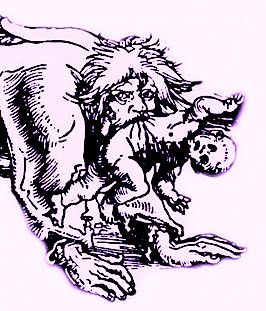Media
Eroti-Kill
There was a time when macabre art trends coincided with extreme serial murder.
Posted February 22, 2014

When I was researching historical accounts of serial murder for The Human Predator, I was struck by a certain period in German history, between the world wars, when violent eroticism in art coincided with some truly deviant serial killers. Here are two examples:
Karl Denke, the “Mass Murderer of Münsterberg,” struck at homeless people as well as guests at his inn. After he killed and butchered them, he kept detailed records of their weight and body parts, and poured buckets of their blood in his open courtyard. He might have even sold some of the meat. For a long time, no one noticed.
After his arrest in 1924 for attacking a young man with an axe, records showed that Denke had consumed parts from as many as 40 people. Not only that, for over three years human flesh had reportedly been his sole source of meat.
After he committed suicide in jail, the police entered his home and discovered dried fingers, pickled flesh, suspenders made from skin, human bones, and other gruesome items. They also found papers from a dozen missing men.
Around the same time, Fritz Haarmann, the “Hanover Vampire,” had been arrested. He was a butcher who’d once spent time in a mental institution. Haarmann teamed up with a handsome male prostitute who could lure boys and homeless young men. For five years, they played their game of “terminal sex.”
Haarmann viewed his victims as prey. At first, he treated them well, but after a long meal, as they grew sleepy, he'd grab them. While raping them, he'd chew into their necks to taste the blood. After they died, he’d remove the internal organs and cut the flesh from their bodies, consume some, and sell the rest. The bones he dumped, usually into a nearby canal.
Then someone found these remains. Since Haarmann lived close by and had a previous arrest record, investigators searched his home. They found clothing from several missing boys and saw bloodstains on the walls. They arrested Haarmann and he confessed.
Armed with grisly evidence for over two-dozen murders (although there were probably twice this many), investigators ensured Haarmann's conviction. He was sentenced to die. Moments before the blade fell to behead him, Haarmann announced that this was his “wedding day.”
After the publicity, some people reportedly developed menschenfleischpsychose, or the irrational fear of eating meat that might be human.
Scholar Maria Tatar linked these killers to the phenomenon in Weimar Germany of popular art like that of Otto Dix, which featured slashed and dismembered victims of serial murder. The artists turned the mutilated female body into an object of fascination. Some did it as a metaphorical statement against the political regime, but others just absorbed and expressed the trend.
Tatar thought the culture's embrace of these artworks could be a psychological strategy for managing collective social tension.
As she noted the sheer number of canvases from the 1920s entitled Lustmord, she found it unsurprising that someone like Haarmann developed as he did. She viewed his behavior as symptomatic of something inarticulate but pervasive.
In fact, some commentaries from this era excused murder as justifiable for those who threatened the masculine social order, inspired self-doubt in males, or deviated from strictly defined social roles. Prime targets for these rants were women and Jews. Outright murder, then, seemed to be an “eroticized release for hatred” or a “retaliatory pleasure” for those who felt like victims.
In other words, Germany's male establishment had been stung by military defeat. They were mentally preparing to reclaim their status and punish those who'd humiliated such a proud country.
In those men who became killers, the membrane was thin between these cultural forces and their own dormant aggression. Their brutality, like the artists' graphic renderings, might have signaled where the culture was heading.
The cannibalistic killers were leaks in the dam that contained the collective psychosis. Their pervasions predicted what would occur in Germany as Hitler took over and subjected whole populations to torture and annihilation.


